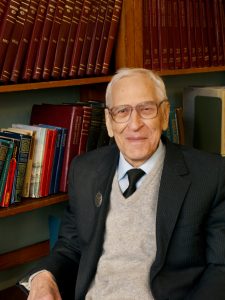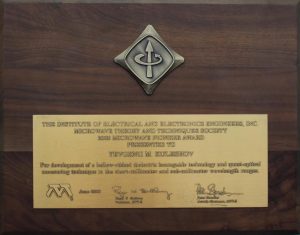 Yevgeny Mitrofanovich Kuleshov, IEEE Life Senior Member, 2000 IEEE Microwave Pioneer, and one of the founding fathers of the Ukrainian and USSR quasi-optics of short-millimeter and sub-millimeter waves, died on the 9-th of February 2016 in Kharkiv, Ukraine. His career and research were highlighted in [1-4], selected publications co-authored by him are given in [5-17], and [18-26] are some of the publications crediting Kuleshov’s contribution to the development of quasi-optical technology and associated applications.
Yevgeny Mitrofanovich Kuleshov, IEEE Life Senior Member, 2000 IEEE Microwave Pioneer, and one of the founding fathers of the Ukrainian and USSR quasi-optics of short-millimeter and sub-millimeter waves, died on the 9-th of February 2016 in Kharkiv, Ukraine. His career and research were highlighted in [1-4], selected publications co-authored by him are given in [5-17], and [18-26] are some of the publications crediting Kuleshov’s contribution to the development of quasi-optical technology and associated applications.
Born on February 21, 1922 in Voronezh, he graduated, in 1946, from the radio-engineering faculty of the Kiev Polytechnic Institute (KPI, now National Technical University of Ukraine “KPI”). In 1946-1955, he worked in the Ukrainian Institute of Physics and Technology (UIPT) in Kharkiv, where he became head of laboratory in 1953.
Kharkiv is the second-largest city of Ukraine (now 1.5 million); it was the capital of the Soviet Ukraine in 1919-1934 and housed up to 40% of Ukrainian industry by 1940. UIPT was founded there in 1929 (see [27] for that story); in 1946-1953, it belonged, in part, to the First Chief Directorate of the so-called Special Committee (of the USSR government) headed by almighty secret police tsar L. P. Beria, who supervised all nuclear research and industry. After Stalin’s death, in 1955, this directorate was renamed in amazingly Orwellian “Newspeak” manner as the Ministry of Medium Machine-Building; whole UIPT belonged to it until the end of the USSR in December of 1991.
In 1955, two departments engaged in millimeter-wave magnetrons and ground-wave radar branched off UIPT to create new Institute of Radio-Physics and Electronics of the National Academy of Sciences of Ukraine (IRE NASU). Kuleshov became head of department of receiving and measuring devices at IRE, later renamed as quasioptics department, and stayed at that post until 1988. At the initial stage, he was designing and developing various general-purpose devices and circuits of the millimeter-wave range (wavelength from 1 to 10 mm) on the basis of standard rectangular waveguides. This became his contribution to the complex work of IRE NASU scientists on the millimeter-wave technologies, awarded with the Lenin Prize, the highest technical prize in the USSR, in 1960. The applications of these circuits were several including the diagnostics of hot plasma in the recently proposed Tokamak nuclear fusion machines. The Tokamaks were built in Moscow, at the Institute of Atomic Energy (IAE), which belonged to the mentioned above Ministry of Medium Machine-Building and was enjoying virtually unlimited funding until the very end of the USSR. In fact, all early buildings of IRE NASU at the Northern entrance to Kharkiv were built by 1959 thanks to massive research funding of Kuleshov’s department from IAE.
However the necessity of mastering even shorter, sub-millimeter wavelength range was obviously not compatible with a further use of the hollow-waveguide technology. Therefore in the mid-1960s to the early-1970s, the innovative work of Kuleshov broke ground on development a wideband quasi-optical components and circuits working in the 0.1 to 2 mm wavelength range. In the beginning, this exploratory work was funded by the Ministry of Radio Industry and had no any true customer. However in the 1970s, such a customer appeared, and extremely wealthy one. This was the same department of hot plasma diagnostics in the Tokamak thermonuclear fusion machines at IAE in Moscow (see [3] for details), which was then building new machines with denser and hotter plasmas and thus was interested in even shorter electromagnetic waves for the diagnostics.
In the heart of all quasi-optical components was innovative idea of the hollow dielectric beam-waveguide (HDB) technology, first proposed in 1964 [3]. In 1972, after a long struggle with secrecy-overwhelmed USSR bureaucracy, it was patented by eight Kharkiv inventors including Kuleshov. HDB had the form of a wide (dozen of wavelengths and more) dielectric tube with the air in the inner channel, encased into a metal cover. The inner surface of the HDB dielectric lining had triangular longitudinal ribs having depth smaller than half-wavelength. In comparison to various other waveguides, the cross-sectional dimension of HDB was significantly larger as compared with the wavelength, and the dielectric lining had relatively large loss tangent (typically around 0.1) and sizable thickness. All this resulted in a specific “self-filtering effect”: the higher-order modes of HDB propagate with significant losses and only the principal HE_11 mode keeps low attenuation [3,19,20]. Quite interestingly, this effect was experimentally established by Kuleshov in the mid-1960 however the full-wave modeling was done only recently in [24,25] by the groups in the UK and Australia working with plastic THz waveguides similar to Kuleshov’s HDB.
Besides of being a team member for the Lenin Prize in 1960, Kuleshov held the USSR titles of Honorary Inventor (1978), Honorary Radio Engineer (1980), and was awarded, as team leader, the State Prize of Ukraine (1972). Worth noting is that the latter prize was awarded entirely for the development of the pioneering HDB technology [3]. Here, its application in Tokamaks of IAE was considered as the most impressive sign of its high usefulness and practicality.
In 1988, Kuleshov retired from the post of department’s head however continued active and fruitful work at IRE NASU, as a senior scientist. At that time his research interests shifted to the application of HDB technology in several promising civilian and defense-oriented areas such as materials testing and radar-cross-section measurements of the downscaled models of sea-borne and air-borne targets [19]. Still the sum-millimeter wave diagnostics of hot plasma inside IAE’s nuclear fusion machines was the most important area of application, which culminated into the 0.195-mm wavelength 9-channel interferometer-polarimeter system installed at Tokamak-15 [7,3]. When Ukraine became independent nation in 1992, the smoke of secrecy around microwave research started getting taken away by fresh winds. The Tokamak studies in Moscow lost their top priority and finally stopped as prohibitively expensive and actually fruitless. Such a change allowed, eventually, Kuleshov’s team to start publishing their results in international technical journals and became internationally visible – see [5-26].
These new circumstances quickly led to remarkable recognition. In 2000, Yevgeny M. Kuleshov was awarded the IEEE Microwave Pioneer Award, with citation “For development of a hollow-ribbed dielectric beamguide technology and quasi-optical measuring techniques of the short-millimeter and sub-millimeter wavelength ranges.” One should be reminded that IEEE Microwave Pioneer Award is considered as being much higher than, for instance, the IEEE Fellow grade because every year around ten MTT Society members are elected Fellows however the Microwave Pioneer is either one or none at all. Before Kuleshov’s success, the Pioneer Award was granted to the scientists from the USA and (a few times only) from Japan however not to any European. Therefore Ukrainian microwave community is now proud of that achievement as a token of high recognition of its contribution to the service to humanity.
It is worth noting that Kuleshov continued working as leading scientist at his department till the very end. In 2013, when his former student and the then head of this department died at the age of 65, Kuleshov had the courage and strength to take responsibility of an important research project of the FP-7 Program. The project was dealing with HDB technology applied to the testing of Carbon-Fiber-Reinforced-Plastic materials used in the Airbus industry – see [14,16,26]. In 2015, he received the Honorable Mention signed by the President of NASU, for the fruitful work and significant contributions to the radio physics and electronics.
It should be also emphasized that Kuleshov was never a member of the USSR Communist Party that was extremely rare exception for a head of department in the USSR science. After 1992, he immediately became interested in international collaboration and was always an active supporter of all activities of the IEEE MTT Society in Kharkiv and Ukraine. He joined the Society in 1996 and was elevated to Senior Membership in 1999. In 2001 and 2002, he served as elected Chairman of the IEEE East Ukraine Joint Chapter, the largest in Ukraine. This was a critical time in chapter’s life because of difficult transition to annual elections of its committee by secret ballot, and Kuleshov’s authority, decency, common sense, and also sense of humor helped greatly in this transition. In 2010, he was granted the status of IEEE Life Senior Member, in recognition of many years of both technical work and volunteering.
Yevgeny M. Kuleshov passed away less than two weeks short of his 94th birthday, in a good sense. His last words were “my bolt is shot.” He was married to his beloved wife, Lyudmyla (Afonicheva) for 59 years until her death in 2011. He is survived by his daughter and son, two grandchildren, and two grand-grandchildren. Ukrainian microwave community has lost a remarkable scientist and valued colleague, the founder of quasi-optics department and one of the founding fathers of IRE NASU. Our hearts and prayers go out to him.
Dr. Y. M. Kuleshov’s IEEE Awards and IEEE Offices
- IEEE Senior Member: 1999
- IEEE MTT-S Microwave Pioneer Award: 2000, for development (in 1964-1972) of a hollow-ribbed dielectric beamguide technology and quasi-optical measuring techniques of the short-millimeter and sub-millimeter wavelength ranges
- IEEE East Ukraine Joint Chapter Chair: 2001-2002, two elected terms
- IEEE Life Senior Member: 2010
- IEEE Honorable Mention: 2010, in recognition of the many years of loyal membership and support of the activities of the IEEE (signed by P. Ray, IEEE President)
- IEEE East Ukraine Joint Chapter International Publication Encouragement Award: 2016, for the paper by P.K. Nesterov, V.V. Yachin ; T.L. Zinenko, and Y.M. Kuleshov, “Characterization of CFRP thermal degradation by the polarization-frequency reflectometry method in subterahertz frequency range,” IEEE Transactions on Terahertz Science and Technology, vol. 6, no 1, pp. 91-98, 2016.
References
Publications highlighting Dr. Y. M. Kuleshov’s career and research
- A. A. Kostenko, A. I. Nosich, and I. A. Tishchenko, “Quasi-optics of near-mm and sub-mm waves in IRE-Kharkov, Ukraine in the 1960-70’s”, Proc. European Microwave Conf. (EuMC-02), Milan, 2002, vol. 1, pp. 247-250.
- A. I. Nosich, Y. M. Poplavko, D. M. Vavriv, and F. J. Yanovsky, “Microwaves in Ukraine,” IEEE Microwave Magazine, 2002, vol. 2, no 4, pp. 82-90.
- I. A. Tishchenko and A. I. Nosich, “Early quasioptics of near-millimeter and submillimeter waves in IRE-Kharkov, Ukraine: From ideas to the microwave pioneer award,” IEEE Microwave Magazine, vol. 4, no 4, pp. 32-44, 2003.
- A. A. Kostenko, A. I. Nosich, and P. F. Goldsmith, “Historical background and development of Soviet quasioptics at near-mm and sub-mm wavelengths,” Chapter 15 in T. Sarkar et al. (Eds.), History of Wireless, New York: Wiley, 2006, pp. 473-542.
Selected publications co-authored by Y. M. Kuleshov
- V. N. Polupanov, Y. M. Kuleshov, and V. K. Kiseliov, “Quasi-optical unidirectional ferrite devices,” Int. J. Infrared Millimeter Waves, vol. 16, no 3, pp 539-546, 1995.
- V. I. Bezborodov, V. K. Kiseliov, B. N. Knyazkov, Y. M. Kuleshov, and M. S. Yanovsky, “An ultra-broadband quasioptical polarization attenuator for metal-dielectric waveguides,” Telecommunic. Radio Eng., vol. 51, no 2-3, pp. 191-194, 1997.
- Y. E. Kamenev, V. K. Kiseliov, Y. M. Kuleshov, B. N. Knyazkov, V. K. Kononenko, P. K. Nesterov, and M. S. Yanovsky, “Submillimeter laser interferometer-polarimeter for plasma diagnostics,” Int. J. Infrared Millimeter Waves, vol. 19, no 6, pp. 835-848, 1998.
- V. K. Kiseliov, V. K. Kononenko, and Y. M. Kuleshov, “Submillimeter quasioptical semiconductor isolators,” IEEE MTT-S Int. Microwave Symp. Digest, vol. 1, pp.569-572, 2000.
- M. I. Ayzatsky, E. Z. Biller, A. N. Dovbnya, I. V. Khodak, V. A. Kushnir, V. V. Mitrochenko, A. N. Opanasenko, S. A. Perezhogin, D. L. Stepin, L. M. Zavada, V. K. Kiseliov, Y. M. Kuleshov, and M. S. Yanovsky, “Bunch-length monitor for an electron linac,” Proc. Int. Particle Accel. Conf. (PAC-2001), Chicago, pp. 2356-2358, 2001.
- V. K. Kiseliov, V. K. Kononenko, and Y. M. Kuleshov, “Submillimeter wave quasioptical isolators with a semiconductor-based circular dichroic mirror,” Int. J. Infrared Millimeter Waves, vol. 26, no 4, pp. 525-544, 2005.
- V. I. Bezborodov, V. K. Kiseliov, Y. M. Kuleshov, and M. S. Yanovsky, “THz band quasi-optical measuring devices based on a square metal-dielectric waveguide,” Proc. Int. Workshop THz Radiation: Basic Research and Applications (TERA-2008), pp. 3-9, 2008.
- V. K. Kiseliov, Y. M. Kuleshov, and M. S. Yanovsky, “THz multifunctional quasi-optical measuring system for education and science,” Proc. IEEE Int. Workshop THz Radiation (TERA), Sebastopol, pp. 267-271, 2010.
- V. I. Bezborodov, V. K. Kiseliov, Y. M. Kuleshov, V. K. Laptiy, P. K. Nesterov, I. V. Scherbatko, and M. S. Yanovsky, “THz/GHz wideband quasioptical spatial multiplexers and demultiplexers of electromagnetic waves,” Telecommunic. Radio Engineering, vol. 71, no 2, pp. 187-195, 2012.
- V. I. Bezborodov, V. K. Kiseliov, Y. M. Kuleshov, P. K. Nesterov, S. V. Mizrakhi, I. V. Shcherbatko, and M. S. Yanovsky, “Sub-terahertz quasi-optical reflectometer for CFRP surface inspection,” Advanced Mat. Res., vol. 664, pp. 547-550, 2013.
- V. I. Bezborodov, O. S. Kosiak, Y. M. Kuleshov, and V. V. Yachin, “Differential phase sections based on form birefringence in the terahertz frequency range,” Telecommunic. Radio Eng., vol. 74, no 8, pp. 735-744, 2015.
- P. K. Nesterov, V. V. Yachin, T. L. Zinenko, and Y. M. Kuleshov. ”Characterization of CFRP thermal degradation by the polarization-frequency reflectometry method in sub-terahertz frequency range,” IEEE Trans. Terahertz Science and Technology, vol. 6, no 1, pp. 91-98, 2016.
- A. A. Galuza, V. K. Kiseliov, I. V. Kolenov, A. I. Belyaeva, and Y. M. Kuleshov, “Developments in THz-range ellipsometry: quasi-optical ellipsometer,” IEEE Trans. Terahertz Science and Technology, vol. 6, no 2, pp. 183-190, 2016.
Publications crediting Dr. Y. M. Kuleshov’s development of HDB and its applications
- N. T. Cherpak, “Millimeter-wavelength maser amplifiers (Review),” Radiophys. Quant. Electron., vol. 27, no 7, pp. 571-601, 1984.
- V. K. Kiseliov, T. M. Kushta, and P. K. Nesterov, “Quasi-optical waveguide modeling method and microcompact scattering range for the millimeter and submillimeter wave bands,” IEEE Trans. Antennas Propagat., vol. 49, no 5, pp. 784-792, 2001.
- T. M. Kushta, K. Yasumoto, and V. K. Kiseliov, “Extinction and scattering of a guided beam in a hollow dielectric waveguide,” J. Opt. Soc. Am A, vol. 18, no 7, pp. 1690-1695, 2001.
- V. Weinzettl, et al., “Overview of the COMPASS diagnostics,” Fusion Eng. Design, vol. 86, pp. 1227–1231, 2011.
- M. Euler and V. F. Fusco, “Quasi optical phase shifter using cascaded split slot ring frequency selective surfaces,” Microw. Opt. Technol. Lett., vol. 53, no 5, pp. 972–974, 2011.
- V. V. Parshin, M. Y. Tretyakov, M. A. Koshelev, and E. A. Serov, “Modern resonator spectroscopy at submillimeter wavelengths,” IEEE Sensors J., vol. 13, no. 1, pp. 18-23, 2013.
- M. Navarro-Cía, J. E. Melzer, A. Harrington, and O. Mitrofanov, “Silver-coated Teflon tubes for waveguiding at 1–2 THz,” J. Infrared Millim. Terahz. Waves, vol. 36, no 6, pp. 542-555, 2015.
- X. Tang, Z. Yu, X. Tu, J. Chen, A. Argyros, B. T. Kuhlmey, and Y. Shi, “Elliptical metallic hollow fiber inner-coated with non-uniform dielectric layer,” Opt. Exp., vol. 23, no 17, pp. 22587-22601, 2015.
- J. Dong, A. Locquet, N. F. Declercq, and D.S. Citrin, “Polarization-resolved terahertz imaging of intra- and inter-laminar damages in hybrid fiber-reinforced composite laminate subject to low-velocity impact,” Composites Part B, vol. 92, pp. 167-174, 2016.
- A.A. Kostenko, A.I. Nosich, and I.A. Tishchenko, “Development of the first Soviet three-coordinate L-band pulsed radar in Kharkov before WWII,” IEEE Antennas Propagat. Mag., vol. 44, no. 3, pp. 29-48, 2001.
Tatiana L. Zinenko
Department of Quasioptics, Institute of Radio-Physics and Electronics NASU
Kharkiv, Ukraine
([email protected])

